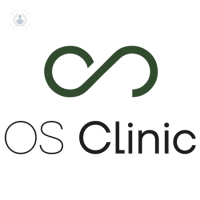What is hip dysplasia?
Hip dysplasia is a condition of the hip joint in which the top of the thigh bone does not fit properly in the socket. This increases the risk of dislocation, i.e. the bone popping out of place. It is often referred to as developmental dysplasia of the hip (DDH) or congenital hip dislocation, as it is usually a problem that is present from birth or early childhood development.
Developmental hip dysplasia can also go hand in hand with a condition called congenital torticollis.

What is the outlook for hip dysplasia?
As long as the condition is diagnosed early and treated, most children with hip dysplasia will develop normally and their hip will have its full range of movement. However, if undiagnosed and untreated, it can cause problems in later life.
What are the symptoms of hip dysplasia?
In developmental dysplasia of the hip, the hip socket is shallow and the head of the femur (thigh bone) is not held tightly in place. This makes it susceptible to dislocation, which can be painful.
Doctors check babies’ hips more than once throughout their development - immediately after birth during the newborn physical examination and again after six to eight weeks. Gentle manipulation of the baby’s hip joints can reveal symptoms such as:
- Discomfort or pain
- The hip feels loose
- One leg may be longer than the other.
If undiagnosed or untreated, hip dysplasia can cause the following symptoms in teenagers and adults:
- Hip pain
- Walking with a limp
- Osteoarthritis, which causes stiff and painful joints
How is hip dysplasia diagnosed?
If a doctor notices a problem during the physical examination of the baby or in other situations, such as multiple births, breech births, premature births, or if there is a family history of the condition, they may order an ultrasound scan.
What are the causes of hip dysplasia?
Before birth, the hip joint is made of soft cartilage as it forms, before hardening and becoming bone after birth. During this time, the ball and socket mechanism of the joint is formed as the top of the thigh bone (the 'ball') and the hip socket mould each other into shape. Shortly before birth, as the baby reaches a size where there is not much space in the womb, the cramped conditions can move the ball of the hip joint out of position, resulting in a shallower socket. Factors that can increase the risk of this happening are:
- Particularly large babies
- First pregnancy
- Breech births
How is hip dysplasia treated?
If diagnosed early, the normal treatment for hip dysplasia is a leg brace, such as a Pavlik harness, which is designed to hold the baby’s thighs in such a way that they press into the socket, helping it to mould into the correct shape.
If the patient is older than six months, surgery may be required to place the ball back in the socket.
Which type of specialist treats hip dysplasia?
Paediatric surgeons, particularly paediatric orthopaedic surgeons treat hip dysplasia in infants and children, while those whose DDH goes unnoticed until adulthood may be treated by orthopaedic surgeons.
07-15-2013 10-24-2023Hip dysplasia
Mr Daniel Phillip Thomas - Orthopaedic surgery
Created on: 07-15-2013
Updated on: 10-24-2023
Edited by: Karolyn Judge
What is hip dysplasia?
Hip dysplasia is a condition of the hip joint in which the top of the thigh bone does not fit properly in the socket. This increases the risk of dislocation, i.e. the bone popping out of place. It is often referred to as developmental dysplasia of the hip (DDH) or congenital hip dislocation, as it is usually a problem that is present from birth or early childhood development.
Developmental hip dysplasia can also go hand in hand with a condition called congenital torticollis.

What is the outlook for hip dysplasia?
As long as the condition is diagnosed early and treated, most children with hip dysplasia will develop normally and their hip will have its full range of movement. However, if undiagnosed and untreated, it can cause problems in later life.
What are the symptoms of hip dysplasia?
In developmental dysplasia of the hip, the hip socket is shallow and the head of the femur (thigh bone) is not held tightly in place. This makes it susceptible to dislocation, which can be painful.
Doctors check babies’ hips more than once throughout their development - immediately after birth during the newborn physical examination and again after six to eight weeks. Gentle manipulation of the baby’s hip joints can reveal symptoms such as:
- Discomfort or pain
- The hip feels loose
- One leg may be longer than the other.
If undiagnosed or untreated, hip dysplasia can cause the following symptoms in teenagers and adults:
- Hip pain
- Walking with a limp
- Osteoarthritis, which causes stiff and painful joints
How is hip dysplasia diagnosed?
If a doctor notices a problem during the physical examination of the baby or in other situations, such as multiple births, breech births, premature births, or if there is a family history of the condition, they may order an ultrasound scan.
What are the causes of hip dysplasia?
Before birth, the hip joint is made of soft cartilage as it forms, before hardening and becoming bone after birth. During this time, the ball and socket mechanism of the joint is formed as the top of the thigh bone (the 'ball') and the hip socket mould each other into shape. Shortly before birth, as the baby reaches a size where there is not much space in the womb, the cramped conditions can move the ball of the hip joint out of position, resulting in a shallower socket. Factors that can increase the risk of this happening are:
- Particularly large babies
- First pregnancy
- Breech births
How is hip dysplasia treated?
If diagnosed early, the normal treatment for hip dysplasia is a leg brace, such as a Pavlik harness, which is designed to hold the baby’s thighs in such a way that they press into the socket, helping it to mould into the correct shape.
If the patient is older than six months, surgery may be required to place the ball back in the socket.
Which type of specialist treats hip dysplasia?
Paediatric surgeons, particularly paediatric orthopaedic surgeons treat hip dysplasia in infants and children, while those whose DDH goes unnoticed until adulthood may be treated by orthopaedic surgeons.


Hip dysplasia in newborns
By Mr Thomas Crompton
2025-01-14
There are procedures need to be undertaken as soon as possible in order to address hip dysplasia in newborns despite the fact that the majority of babies can be treated without surgery. Mr Thomas Crompton, leading consultant orthopaedic surgeon, discusses how important diagnosis and treatment for hip dysplasia is. See more


Highlighting hip dysplasia
By Mr Giles Stafford
2025-01-13
Hip dysplasia can happen at any age, not just people who are of an older age. Top Doctors speaks to Mr Giles Stafford, leading consultant orthopaedic hip surgeon, for his expert advice on signs, treatment and management of the condition. See more


What is developmental dysplasia of the hip (DDH)?
By Dr Claudia Maizen
2025-01-12
Developmental dysplasia of the hip (DDH) is a common condition affecting infants and young children. It involves abnormal development of the hip joint, which can lead to various complications if not treated promptly. Here, Dr Claudia Maizen, renowned consultant paediatric orthopaedic and trauma surgeon, offers an expert insight into DDH. See more


A parent's guide to DDH in babies and young children
By Mr Thomas Crompton
2025-01-08
Developmental dysplasia of the hip (DDH) is a hip condition in which the ball and socket joint doesn't form properly in babies and young children. Orthopaedic surgeon, Mr Thomas Crompton explains what causes it and how it can be treated. See more
Experts in Hip dysplasia
-
Mr Thomas Crompton
Paediatric orthopaedicsExpert in:
- Cerebral palsy
- Neuromuscular disease
- Limb lengthening
- Pediatric hip
- Flat feet
- Hip dysplasia
-
Mr Nigel Kiely
Paediatric orthopaedicsExpert in:
- Knee surgery
- Flat feet
- Pediatric knee
- Congenital hip dislocation
- Club foot
- Hip dysplasia
-
Mr Gareth Roberts
Orthopaedic surgeryExpert in:
- Osteoarthritis of the hip
- Hip replacement
- Osteotomy
- Hip arthroscopy
- Hip dysplasia
- Femoro-acetabular impingement
-
Mr Giles Stafford
Orthopaedic surgeryExpert in:
- Hip
- Osteoarthritis of the hip
- Hip arthroscopy
- Femoro-acetabular impingement
- Sports injuries
- Hip replacement
-
Mr Gregory Firth
Paediatric orthopaedicsExpert in:
- Paediatric orthopaedics
- Limb lengthening
- Club foot
- Hip dysplasia
- Neuromuscular disease
- Traumatic injury
- See all

OS Clinic
OS Clinic
OS Clinic, 45 Queen Anne St, London W1G 9JF
No existe teléfono en el centro.
By using the telephone number provided by TOP DOCTORS, you automatically agree to let us use your phone number for statistical and commercial purposes. For further information, read our Privacy Policy
Top Doctors

The Wellington Hospital - part of HCA Healthcare
The Wellington Hospital - part of HCA Healthcare
Wellington Hospital South Bldg, 8A Wellington Pl, NW8 9LE
No existe teléfono en el centro.
By using the telephone number provided by TOP DOCTORS, you automatically agree to let us use your phone number for statistical and commercial purposes. For further information, read our Privacy Policy
Top Doctors

Cleveland Clinic London Hospital
Cleveland Clinic London Hospital
33 Grosvenor Place
No existe teléfono en el centro.
By using the telephone number provided by TOP DOCTORS, you automatically agree to let us use your phone number for statistical and commercial purposes. For further information, read our Privacy Policy
Top Doctors
-
OS Clinic
OS Clinic, 45 Queen Anne St, London W1G 9JF, W1G Marylebone LondonExpert in:
- Hip
- Minimal access surgery (keyhole surgery)
- Joint preservation surgery
- Maxillofacial Surgery
- Orthopaedic surgery
- Orthopaedic spinal surgery
-
The Wellington Hospital - part of HCA Healthcare
Wellington Hospital South Bldg, 8A Wellington Pl, NW8 9LE, Central LondonExpert in:
- Digestive
- Cardiology
- Orthopaedic surgery
- Orthopaedic spinal surgery
- Intensive care
- Spine
-
Cleveland Clinic London Hospital
33 Grosvenor Place, Central LondonExpert in:
- Cardiology
- Colorectal surgery
- Minimal access surgery (keyhole surgery)
- Gallbladder surgery
- Diagnostic Imaging
- Ultrasound
- Most viewed diseases, medical tests, and treatments
- Ulnar nerve entrapment
- Peripheral nerve block
- Peripheral neuropathy
- Undescended testicle (Cryptorchidism)
- Joint pain
- Lumbar herniated disc
- Abdominal pain
- Spinal surgery
- Minimal access surgery (keyhole surgery)
- Shoulder pain








